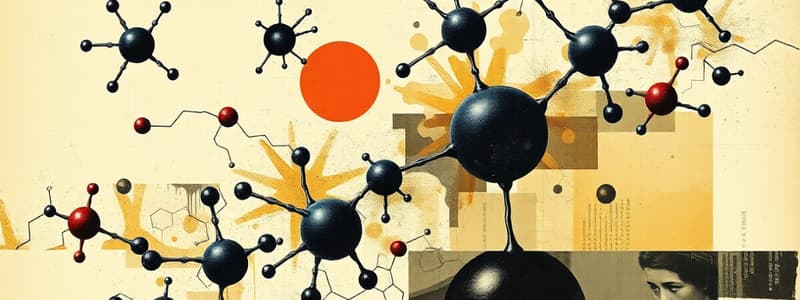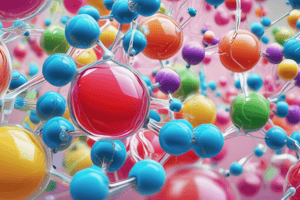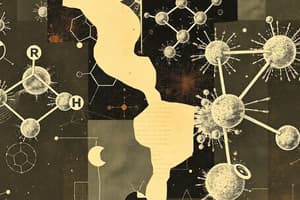Podcast
Questions and Answers
Which of the following elements is NOT one of the four most common elements found in the human body?
Which of the following elements is NOT one of the four most common elements found in the human body?
- Calcium (correct)
- Hydrogen
- Carbon
- Oxygen
Inorganic compounds do not contain carbon.
Inorganic compounds do not contain carbon.
True (A)
Name two types of organic compounds that are found in living organisms.
Name two types of organic compounds that are found in living organisms.
Carbohydrates, Proteins
The most abundant organic compound on earth is ______.
The most abundant organic compound on earth is ______.
Match the following elements with their percentage based on mass in the human body:
Match the following elements with their percentage based on mass in the human body:
Which of the following is considered an inorganic molecule?
Which of the following is considered an inorganic molecule?
Vitamins are classified as inorganic compounds.
Vitamins are classified as inorganic compounds.
What element is essential for the formation of proteins?
What element is essential for the formation of proteins?
Carbon-containing compounds that are essential for life are referred to as ______ compounds.
Carbon-containing compounds that are essential for life are referred to as ______ compounds.
Which of the following elements is found in haemoglobin in blood?
Which of the following elements is found in haemoglobin in blood?
Which disaccharide is formed by the union of a glucose molecule with a galactose molecule?
Which disaccharide is formed by the union of a glucose molecule with a galactose molecule?
Sucrose is sweeter than lactose.
Sucrose is sweeter than lactose.
What is the primary polysaccharide that serves as energy storage in animals?
What is the primary polysaccharide that serves as energy storage in animals?
The type of carbohydrate that stores in plants is called __________.
The type of carbohydrate that stores in plants is called __________.
Match the polysaccharides with their respective characteristics:
Match the polysaccharides with their respective characteristics:
What percentage of lactose is typically found in human milk?
What percentage of lactose is typically found in human milk?
Cellulose is completely digested in the human digestive system.
Cellulose is completely digested in the human digestive system.
Where is maltose primarily found?
Where is maltose primarily found?
The structural unit of cellulose, starch, and glycogen is __________.
The structural unit of cellulose, starch, and glycogen is __________.
Match the disaccharides with their sources:
Match the disaccharides with their sources:
What color indicates a positive test for starch when iodine solution is added?
What color indicates a positive test for starch when iodine solution is added?
Sucrose will show a color change when tested with Benedict solution on its own.
Sucrose will show a color change when tested with Benedict solution on its own.
What are the four elements always present in proteins?
What are the four elements always present in proteins?
The simplest amino acid is _____ and has Hydrogen as its R group.
The simplest amino acid is _____ and has Hydrogen as its R group.
Match the food to its protein content:
Match the food to its protein content:
Which of the following statements is true regarding the color changes during a glucose test?
Which of the following statements is true regarding the color changes during a glucose test?
Proteins can serve as an energy source when carbohydrates and lipids are insufficient.
Proteins can serve as an energy source when carbohydrates and lipids are insufficient.
What percentage of the mature human body is composed of proteins?
What percentage of the mature human body is composed of proteins?
Amino acids that cannot be synthesized by the body are known as _____ amino acids.
Amino acids that cannot be synthesized by the body are known as _____ amino acids.
Which amino acid structure is characterized by having a generic 'R' group that contains both Carbon and Hydrogen?
Which amino acid structure is characterized by having a generic 'R' group that contains both Carbon and Hydrogen?
Which of the following is a monosaccharide?
Which of the following is a monosaccharide?
Disaccharides consist of three monosaccharides joined together.
Disaccharides consist of three monosaccharides joined together.
What is the common molecular formula for carbohydrates?
What is the common molecular formula for carbohydrates?
The sweet sugar formed during the ripening of fruits is called ______.
The sweet sugar formed during the ripening of fruits is called ______.
Match the following disaccharides with their corresponding components:
Match the following disaccharides with their corresponding components:
Which monosaccharide is known as 'the end product during hydrolysis of all starchy food'?
Which monosaccharide is known as 'the end product during hydrolysis of all starchy food'?
Polysaccharides are known to be simple sugars.
Polysaccharides are known to be simple sugars.
What is released when two monosaccharides combine to form a disaccharide?
What is released when two monosaccharides combine to form a disaccharide?
Glucose, fructose, and galactose are examples of ______.
Glucose, fructose, and galactose are examples of ______.
Which of the following is NOT a characteristic of monosaccharides?
Which of the following is NOT a characteristic of monosaccharides?
Flashcards
Starch Test
Starch Test
A chemical test used to identify the presence of starch in a sample. A drop of iodine solution is added to the sample. A purplish-blue color indicates the presence of starch.
Glucose Test
Glucose Test
A chemical test used to identify the presence of glucose in a sample. Benedict's solution is added to the sample and heated. Color changes from blue to green to orange to brick red indicate increasing glucose concentration.
What is Protein?
What is Protein?
A complex molecule consisting of long chains of amino acids. Plays crucial roles in various biological processes.
Amino Acids
Amino Acids
Signup and view all the flashcards
Essential Amino Acids
Essential Amino Acids
Signup and view all the flashcards
Myosin and Actin
Myosin and Actin
Signup and view all the flashcards
Osein
Osein
Signup and view all the flashcards
Hemoglobin
Hemoglobin
Signup and view all the flashcards
Keratin
Keratin
Signup and view all the flashcards
Proteins as Energy Source
Proteins as Energy Source
Signup and view all the flashcards
What is maltose?
What is maltose?
Signup and view all the flashcards
What is sucrose?
What is sucrose?
Signup and view all the flashcards
What is lactose?
What is lactose?
Signup and view all the flashcards
What is cellulose?
What is cellulose?
Signup and view all the flashcards
What is starch?
What is starch?
Signup and view all the flashcards
What is glycogen?
What is glycogen?
Signup and view all the flashcards
What is the significance of carbohydrates as an energy source?
What is the significance of carbohydrates as an energy source?
Signup and view all the flashcards
How do carbohydrates act as storage compounds?
How do carbohydrates act as storage compounds?
Signup and view all the flashcards
What is the structural role of carbohydrates?
What is the structural role of carbohydrates?
Signup and view all the flashcards
How are carbohydrates involved in nucleic acids?
How are carbohydrates involved in nucleic acids?
Signup and view all the flashcards
Organic Compounds
Organic Compounds
Signup and view all the flashcards
Inorganic Compounds
Inorganic Compounds
Signup and view all the flashcards
Biomolecules
Biomolecules
Signup and view all the flashcards
Carbohydrates
Carbohydrates
Signup and view all the flashcards
Proteins
Proteins
Signup and view all the flashcards
Lipids
Lipids
Signup and view all the flashcards
Nucleic Acids
Nucleic Acids
Signup and view all the flashcards
Vitamins
Vitamins
Signup and view all the flashcards
Water
Water
Signup and view all the flashcards
Minerals
Minerals
Signup and view all the flashcards
What are carbohydrates?
What are carbohydrates?
Signup and view all the flashcards
What are monosaccharides?
What are monosaccharides?
Signup and view all the flashcards
What are disaccharides?
What are disaccharides?
Signup and view all the flashcards
What are polysaccharides?
What are polysaccharides?
Signup and view all the flashcards
Study Notes
Chemical Basis of Life
- Living organisms are made of various chemical compounds, formed from the bonding of naturally occurring elements.
- Only about 25 elements are found in living organisms, out of the 92 elements found in nature.
- The four most common elements in living organisms are Carbon, Hydrogen, Oxygen, and Nitrogen (CHO and N)
- Other important elements essential for life include Sulfur, Phosphorus, Sodium, Potassium, Calcium, Magnesium, Iron, and Chlorine.
- Figure 1.1 shows the relative percentages of these elements in the human body, with Oxygen (O) being the most prevalent (around 65%).
Chemical Compounds
- Chemical compounds in living things are categorized as organic (containing Carbon) or inorganic (lacking Carbon).
- Organic compounds crucial for life are known as biomolecules.
- Four main types of biomolecules are:
- Carbohydrates
- Proteins
- Lipids
- Nucleic acids
Carbohydrates
-
Carbohydrates are the most abundant organic compounds on Earth, produced by photosynthesis in plants.
-
Common examples of carbohydrate sources include fruits, potatoes, grains, sugar, and flour.
-
Carbohydrates are composed of Carbon (C), Hydrogen (H), and Oxygen (O) atoms.
-
Hydrogen and oxygen combine in a 2:1 ratio.
-
Carbohydrates are classified into three groups based on structure:
-
Monosaccharides (simple sugars): Basic units of carbohydrates with formulae like Glucose (C6H12O6), Fructose, and Galactose.
-
Disaccharides (double sugars): Formed by joining two monosaccharides (e.g., Sucrose, Lactose).
-
Polysaccharides (complex sugars): Long chains of monosaccharides (e.g., Starch, Cellulose, Glycogen).
-
Monosaccharides (e.g. glucose, fructose, and galactose) are found in different natural foods or plants.
-
Disaccharides (e.g. maltose, sucrose, and lactose) are formed by combining two monosaccharides. The basic chemical unit is the condensation of two monosaccharides releasing a water molecule (H2O).
-
Polysaccharides (e.g. starch, cellulose, and glycogen) are involved in the storage and structural components in plants.
Proteins
- Proteins are essential components of all living cells, composed of amino acids.
- Proteins makeup about 17% of the human body.
- Important sources of proteins include meat, fish, eggs, and some plant-based products like cereals.
- Proteins are made from different combinations of 20 amino acids.
- Amino acids contain both Carbon (C) and Hydrogen (H), but also Nitrogen (N); and sometimes Sulphur (S).
- Some amino acids cannot be produced by the body and must be obtained from food (essential amino acids).
- Proteins have various functions in cells/organisms, such as catalyzing reactions (enzymes), making structures, and regulating body processes (hormones).
Studying That Suits You
Use AI to generate personalized quizzes and flashcards to suit your learning preferences.




